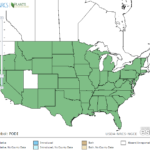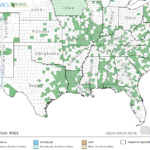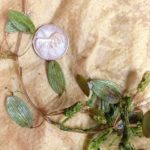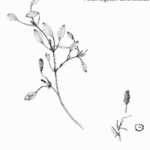Potamogeton diversifolius
USDA, NRCS. 2018. The PLANTS Database (http://plants.usda.gov, 28 March 2018). National Plant Data Team, Greensboro, NC 27401-4901 USA.
Illustration courtesy of University of Florida/IFAS Center for Aquatic and Invasive Plants. Used with permission.
What is Waterthread Pondweed?
Physical Characteristics
Leaves:
Submersed Leaves:
- Thin and Straight
- Pale green
- Mostly 0.78-2.5 inches long
- 0.02-0.06 inches wide
- Slightly reducing in thickness from an immobile base
- Midrib usually bordered by 1-4 rows of cavities
- Peduncles 0.02-0.16 inches long from axils
Small Leaves:
- Delicately fibrous
- Growing from base of large leaf blade
Floating Leaves:
- Leather texture
- Oval- or elliptical- shaped
- Rounded at base
- Leaf stalks usually shorter than blades
- Blades 1.5 inches long & 0.78 inches wide
- Peduncles usually slender, often club-shaped
- Peduncles 0.08-1.19 inches long from axils
- Peduncles grow upward or arching
Small Leaves:
- Free from leaf stalks
- Up to 0.25 inches long
- Delicately fibrous
- Long-lived
Flowers:
Submersed Spikes:
- Few flowers
- Almost spherical
Emersed Spikes:
- 0.2-0.78 inches long
- Flowers nearly immobile
- Fruit 0.13-0.16 inches wide
Fruit:
- Almost disk-shaped
- Sides flattened or slightly curving inward
- 0.02-0.03 inches in diameter
Stem:
- Horizontal root branching
- Threadlike
- Cylindrical
Roots:
- Rooting at nodes
Where Does it Grow?
Waterthread pondweed can be found in pools, tanks and small streams.
Pros and Cons of Waterthread Pondweed
Waterthread pondweed seeds are consumed by waterfowl. Submerged portions of all aquatic plants provide habitats for many micro and macro invertebrates. These invertebrates in turn are used as food by fish and other wildlife species (e.g. amphibians, reptiles, ducks, etc.). After aquatic plants die, their decomposition by bacteria and fungi provides food (called “detritus”) for many aquatic invertebrates.





